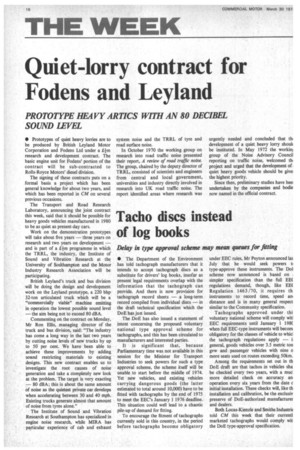Quiet-lorry contract for Fodens and Leyland
Page 16

If you've noticed an error in this article please click here to report it so we can fix it.
PROTOTYPE HEAVY ARMS WITH AN 80 DECIBEL SOUND LEVEL
• Prototypes of quiet heavy lorries are to be produced by British Leyland Motor Corporation and Fodens Ltd under a Efin research and development contract. The basic engine unit for Fodens' portion of the contract will be sub-contracted to Rolls-Royce Motors' diesel division.
The signing of these contracts puts on a formal basis a project which has been general knowledge for about two years, and which has been reported in CM on several previous occasions.
The Transport and Road Research Laboratory, announcing the joint contract this week, said that it should be possible for heavy goods vehicles manufactured in 1980 to be as quiet as present-day cars.
Work on the demonstration prototypes will take about five years — three years on research and two years on development — and is part of a flm programme in which the TRRL, the industry, the Institute of Sound and Vibration Research at the University of Scnithampton and the Motor Industry Research_ Association will be participating.
British Leyland's truck and bus division will be doing the design and development work on the Leyland prototype, a 220 bhp • 32-ton articulated truck which will be a "commercially viable" machine emitting in operation the lowest possible sound level — the aim being not to exceed 80 dBA.
Commenting on the contract on Monday, Mr Ron Ellis, managing director of the truck and bus division, said: "The industry has come a long way in the last two years by cutting noise levels of new trucks by up to 50per cent. We have been able to achieve these improvements by adding sound restricting materials to existing designs. This new contract enables us to investigate the root causes of noise generation and take a completely new look at the problem. The target is very exacting
— 80 dBA; this is about the same amount of noise as the quietest private car develops when accelerating between 30 and 40 mph. Existing trucks generate almost that amount of noise from tyres alone."
The Institute of Sound and Vibration Research at Southampton has specialized in engine noise research, while MIRA has particular experience of cab and exhaust system noise and the TRRL of tyre and road surface noise.
. In October 1970 the working group on research into road traffic noise presented their report, A review of road traffic noise. The group, chaired by the deputy director of TRRL, consisted of scientists and engineers from central and local government, universities and industry directly involved in research into UK road traffic noise. The report identified areas where research was urgently needed and concluded that tb development of a quiet heavy lorry shoul■ be instituted. In• May 1972 the workir.q group of the Noise Advisory Council reporting on traffic noise, welcomed di' project and urged that the development of quiet heavy goods vehicle should be givei the highest priority.
Since then, preliminary studies have bee] undertaken by the companies and bodie now named in the official contract.










































































































